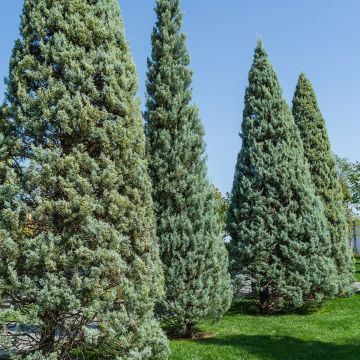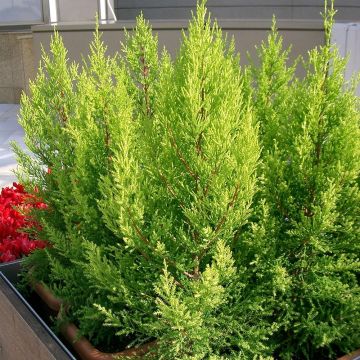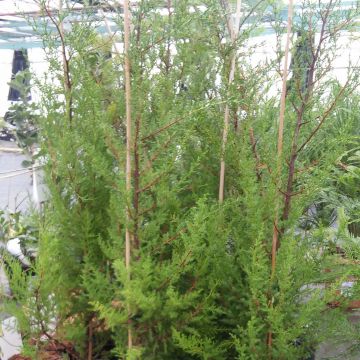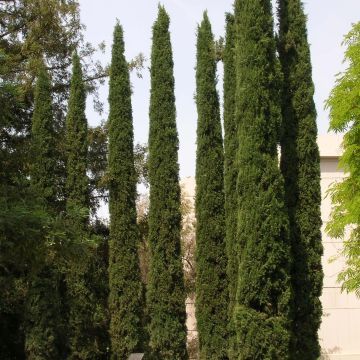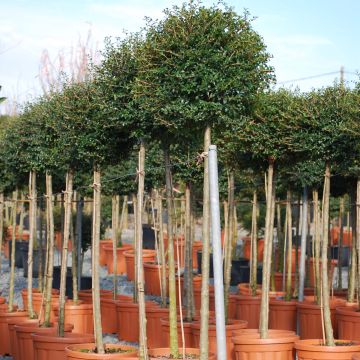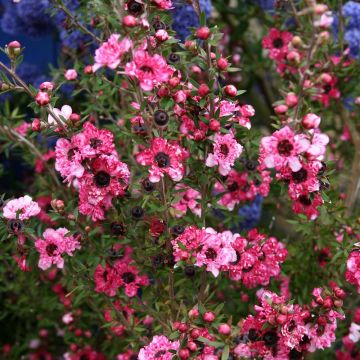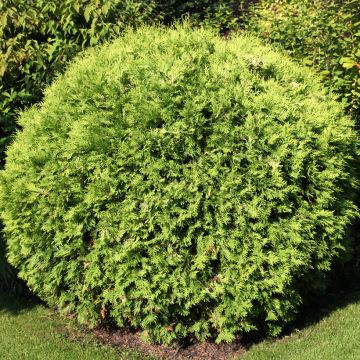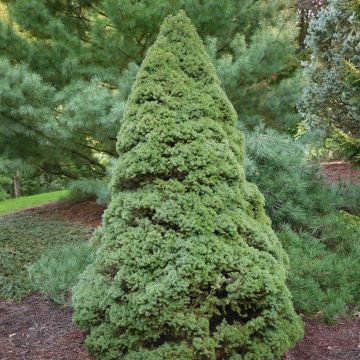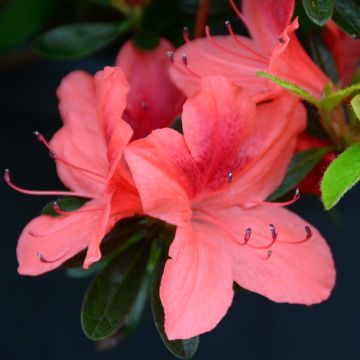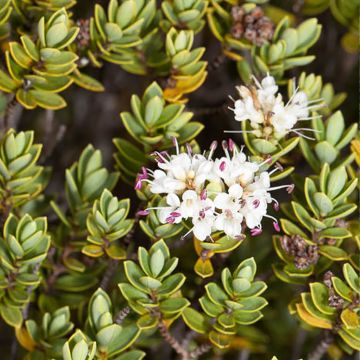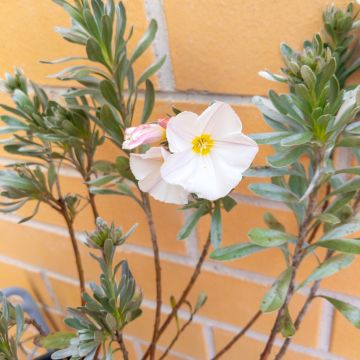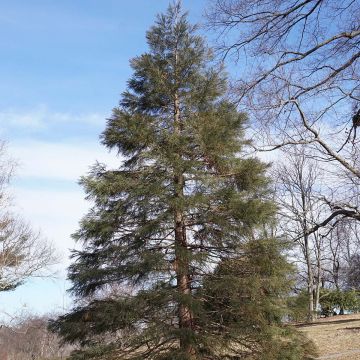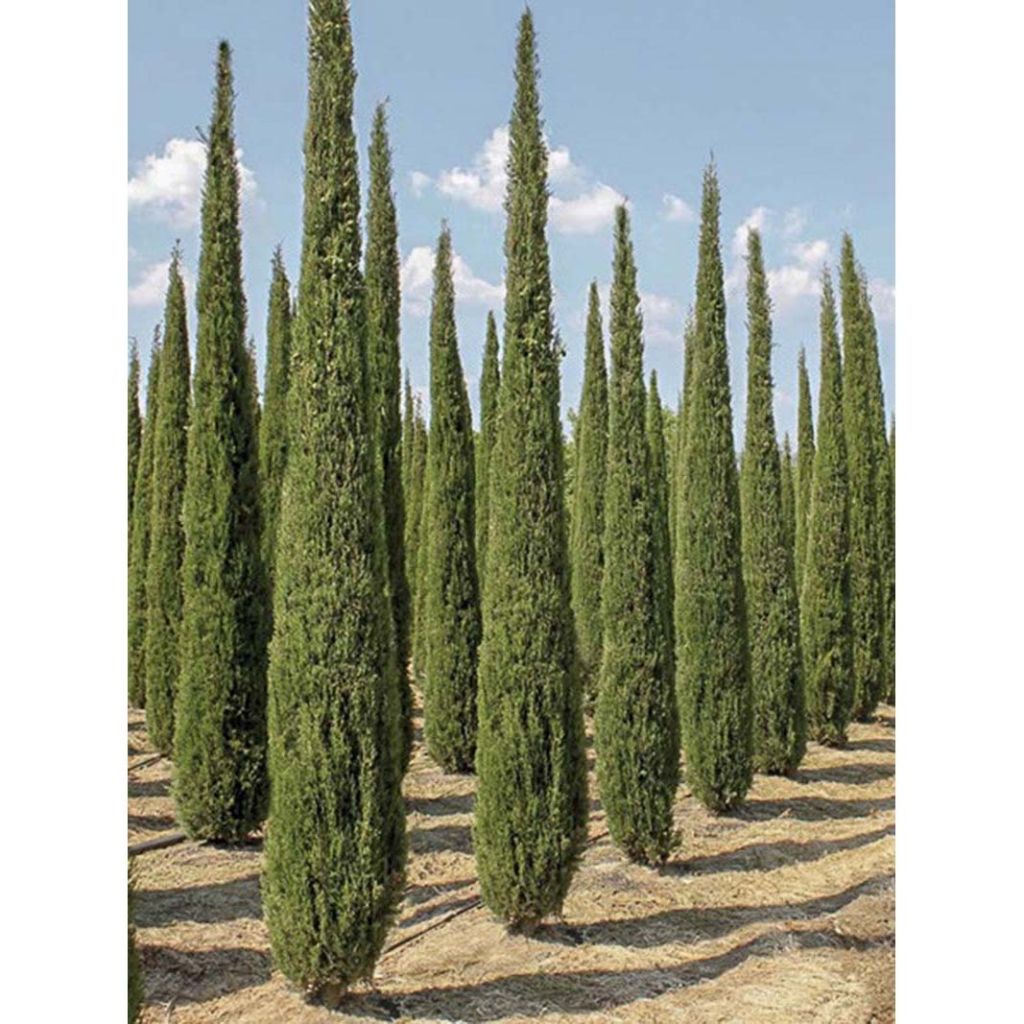

Cupressus sempervirens Garda
Cupressus sempervirens Garda
Cupressus sempervirens Garda
Mediterranean Cypress, Italian Cypress, Pencil Pine, Graveyard Cypress
Can it be planted in a pot?
gallus, 27/03/2024
This plant carries a 24 months recovery warranty
More information
We guarantee the quality of our plants for a full growing cycle, and will replace at our expense any plant that fails to recover under normal climatic and planting conditions.
From €5.90 for pickup delivery and €6.90 for home delivery
Express home delivery from €8.90.

Does this plant fit my garden?
Set up your Plantfit profile →
Description
The Cupressus sempervirens 'Garda', commonly known as the Provence cypress or Florence cypress, was selected near Lake Garda in the Italian Alps. This variety has a tall, slender habit, with a tapered but dense columnar shape, and thick foliage of a vibrant green colour. Unlike the classic evergreen cypress, it produces few fruits, allowing it to maintain a compact growth and an impeccable silhouette over time. This large conifer is perfect for accentuating an entrance or structuring a garden. It thrives in sunny, well-drained soil, even rocky, poor, and dry in summer.
The Cupressus sempervirens is a species in the cupressaceae family. It is believed to originate from Asia but has been acclimated for a long time in Mediterranean regions due to its excellent adaptation to drought, wind, and poor soils. In nature, it is found in dry and open forests, usually on limestone or rocky soil. Similar to Chamaecyparis, it differs with its rounded branchlets arranged in tufts around the main axis, and larger cones with woody scales. 'Garda' is a recent variety, part of the 'stricta' group, which gathers plants selected for their upright habit rather than horizontal.
'Garda' is a tall and narrow variety, reaching a height of 10m (32 ft 10 in) but with a spread not exceeding 1.50m. At the age of 6, under good conditions, it can already reach a height of 7m (23 ft). This variety has thick branchlets and the advantage of producing almost no fruits, which would weigh down and widen the crown, resulting in an untidy appearance. Well-branched from the base, compact, and upright, 'Garda' proudly displays its beautiful aromatic foliage, of a vibrant green colour, on consistently erect branches. Like all common cypresses, its wood is fragrant and reveals resin under a relatively thin and fissured brown-gray bark that peels off in strips. Its root system is of the taproot type, allowing it to anchor deeply in the soil to draw water and nutrients and resist even strong winds.
The Italian Cypress 'Garda' is perfect for framing an entrance, planted in groups of three, as was done in the past in Provence to welcome visitors and indicate a human presence. Its slender column elegantly structures a garden, whether it is contemporary, Italian, or Mediterranean in style. It can also be used as a standalone specimen, surrounded by gray foliage (Artemisias, Lavenders, Perovskia atriplicifolia 'Blue Spire') or in a large evergreen hedge. It can also be placed in front of a persistent screen composed of strawberry trees, Evergreen Oak, Common Juniper and its varieties, Elaeagnus ebbingei and Laurel Tin, for example.
Report an error about the product description
Cupressus sempervirens Garda in pictures
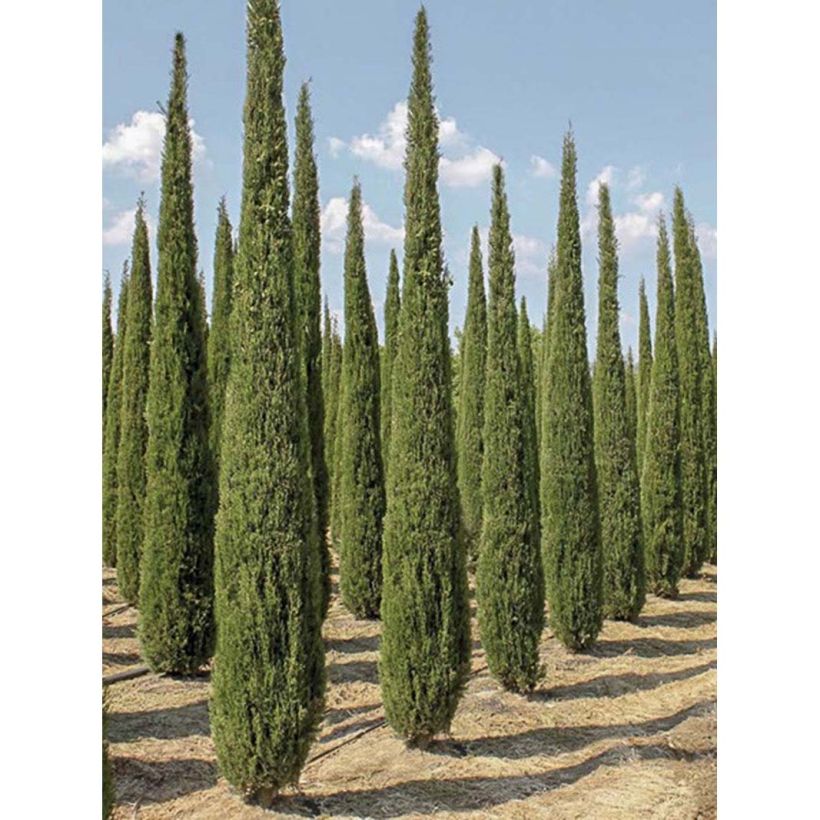

Plant habit
Foliage
Safety measures
Botanical data
Cupressus
sempervirens
Garda
Cupressaceae
Mediterranean Cypress, Italian Cypress, Pencil Pine, Graveyard Cypress
Cultivar or hybrid
atteinterespiratoire
Cette plante peut entraîner des symptômes allergiques.
Evitez de la planter si vous ou vos proches souffrez de rhinite saisonnière ("rhume des foins").
Davantage d'informations sur https://plantes-risque.info
Other Cupressus
Planting and care
Install the Garda evergreen Cypress in a sunny and open position in well-drained soil, even stony and poor soil, even particularly rocky, as its taproot will find a crack and widen it to go down and find water, often present in the subsoil of limestone formations. It is preferable to try growing it in areas with not too harsh winters (USDA zone 8 to 10). This plant theoretically withstands without problems down to at least -15°C (5 °F), but things get complicated in compact, clayey soil that is waterlogged in winter, as is the case for many Mediterranean plants. The adaptation to limestone and strong winds (Mistral and Tramontane) of the sempervirens species makes it a strong element of the Mediterranean landscape.
Planting period
Intended location
Care
-
, onOrder confirmed
Reply from on Promesse de fleurs
Evergreen shrubs
Haven't found what you were looking for?
Hardiness is the lowest winter temperature a plant can endure without suffering serious damage or even dying. However, hardiness is affected by location (a sheltered area, such as a patio), protection (winter cover) and soil type (hardiness is improved by well-drained soil).

Photo Sharing Terms & Conditions
In order to encourage gardeners to interact and share their experiences, Promesse de fleurs offers various media enabling content to be uploaded onto its Site - in particular via the ‘Photo sharing’ module.
The User agrees to refrain from:
- Posting any content that is illegal, prejudicial, insulting, racist, inciteful to hatred, revisionist, contrary to public decency, that infringes on privacy or on the privacy rights of third parties, in particular the publicity rights of persons and goods, intellectual property rights, or the right to privacy.
- Submitting content on behalf of a third party;
- Impersonate the identity of a third party and/or publish any personal information about a third party;
In general, the User undertakes to refrain from any unethical behaviour.
All Content (in particular text, comments, files, images, photos, videos, creative works, etc.), which may be subject to property or intellectual property rights, image or other private rights, shall remain the property of the User, subject to the limited rights granted by the terms of the licence granted by Promesse de fleurs as stated below. Users are at liberty to publish or not to publish such Content on the Site, notably via the ‘Photo Sharing’ facility, and accept that this Content shall be made public and freely accessible, notably on the Internet.
Users further acknowledge, undertake to have ,and guarantee that they hold all necessary rights and permissions to publish such material on the Site, in particular with regard to the legislation in force pertaining to any privacy, property, intellectual property, image, or contractual rights, or rights of any other nature. By publishing such Content on the Site, Users acknowledge accepting full liability as publishers of the Content within the meaning of the law, and grant Promesse de fleurs, free of charge, an inclusive, worldwide licence for the said Content for the entire duration of its publication, including all reproduction, representation, up/downloading, displaying, performing, transmission, and storage rights.
Users also grant permission for their name to be linked to the Content and accept that this link may not always be made available.
By engaging in posting material, Users consent to their Content becoming automatically accessible on the Internet, in particular on other sites and/or blogs and/or web pages of the Promesse de fleurs site, including in particular social pages and the Promesse de fleurs catalogue.
Users may secure the removal of entrusted content free of charge by issuing a simple request via our contact form.
The flowering period indicated on our website applies to countries and regions located in USDA zone 8 (France, the United Kingdom, Ireland, the Netherlands, etc.)
It will vary according to where you live:
- In zones 9 to 10 (Italy, Spain, Greece, etc.), flowering will occur about 2 to 4 weeks earlier.
- In zones 6 to 7 (Germany, Poland, Slovenia, and lower mountainous regions), flowering will be delayed by 2 to 3 weeks.
- In zone 5 (Central Europe, Scandinavia), blooming will be delayed by 3 to 5 weeks.
In temperate climates, pruning of spring-flowering shrubs (forsythia, spireas, etc.) should be done just after flowering.
Pruning of summer-flowering shrubs (Indian Lilac, Perovskia, etc.) can be done in winter or spring.
In cold regions as well as with frost-sensitive plants, avoid pruning too early when severe frosts may still occur.
The planting period indicated on our website applies to countries and regions located in USDA zone 8 (France, United Kingdom, Ireland, Netherlands).
It will vary according to where you live:
- In Mediterranean zones (Marseille, Madrid, Milan, etc.), autumn and winter are the best planting periods.
- In continental zones (Strasbourg, Munich, Vienna, etc.), delay planting by 2 to 3 weeks in spring and bring it forward by 2 to 4 weeks in autumn.
- In mountainous regions (the Alps, Pyrenees, Carpathians, etc.), it is best to plant in late spring (May-June) or late summer (August-September).
The harvesting period indicated on our website applies to countries and regions in USDA zone 8 (France, England, Ireland, the Netherlands).
In colder areas (Scandinavia, Poland, Austria...) fruit and vegetable harvests are likely to be delayed by 3-4 weeks.
In warmer areas (Italy, Spain, Greece, etc.), harvesting will probably take place earlier, depending on weather conditions.
The sowing periods indicated on our website apply to countries and regions within USDA Zone 8 (France, UK, Ireland, Netherlands).
In colder areas (Scandinavia, Poland, Austria...), delay any outdoor sowing by 3-4 weeks, or sow under glass.
In warmer climes (Italy, Spain, Greece, etc.), bring outdoor sowing forward by a few weeks.


































